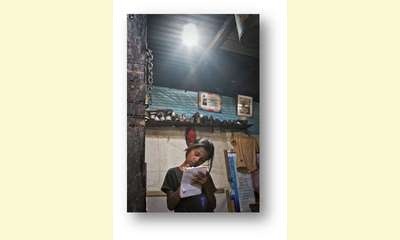|
|
Solidarity erases darkness
an article by Natalia Rocha and Omar Salinas
Video: Un invento
interesante con una botella de plástico)
Development has become crucial for improving the quality of life.
The video “Un invento interesante con una botella de plastico” (An
interesting invention with a plastic bottle) shows how people can
create alternatives to the conventional energy resources through
solidarity, a key factor for the implementation of the Culture of
Peace. 
Lite on devolpment
click on photo to enlarge
Because of people’s economic limitations, the topic of Sustainable
The reuse of waste that normally would go to the garbage
is the essential element to illuminate each of the houses of
Maligaya, a little town in Philippines, where due to the kind of
construction of the houses, they lack sunlight and enough
economic resources to pay the service of electric energy.
The mix of plastic bottles, chlorine and water embedded in the
ceiling of the houses makes easier for the sunlight to come into
the houses as if it were a light bulb. This solar bottle, which was
the idea of one inhabitant’s mind, has benefitted 643 houses and
they have improved their human development because now they
have access to light. Furthermore, this has contributed to citizen
participation as all people contribute to the development of their
community and they get involved on the activities. Finally, what
could have been a socio-environmental problem, for this
community has become a contribution to the construction of the
Culture of Peace.
(Click here for a Spanish version of this article)
|








|
DISCUSSION
Question(s) related to this article:
What renewable technologies can best meet Third World energy needs?,
* * * * *
Latest reader comment:
The following report comes to us via The Good News Agency which is available on the Internet at http://www.goodnewsagency.org.
Meeting the food security challenge through organic agriculture.
States should integrate organic agriculture objectives within national priorities, FAO says.
Rome, 3 May – “Organic agriculture is no longer a phenomenon in developed countries only, as it is commercially practiced in 120 countries, representing 31 million hectares and a market of US$ 40 billion in 2006,” FAO underlines in a paper Organic Agriculture and Food Security presented here at an International Conference on Organic Agriculture and Food Security (3-5 May 2007).
The paper identifies the strengths and weaknesses of organic agriculture with regards to its contribution to food security. analyzes attributes of organic supply chains against the Right to Food framework and proposes policy and research actions for improving the performance of organic agriculture at the national, international and institutional levels.
“The strongest feature of organic agriculture is its reliance on fossil-fuel independent and locally-available production assets. working with natural processes increases cost-effectiveness and resilience of agro-ecosystems to climatic stress,” the paper says.
“By managing biodiversity in time (rotations) and space (mixed cropping), organic farmers use their labour and environmental services to intensify production in a sustainable way. Organic agriculture also breaks the vicious circle of indebtedness for agricultural inputs which causes an alarming rate of farmers’ suicides.”
The paper recognizes that “most certified organic food production in developing countries goes to export” and adds that “when certified cash crops are linked with agro-ecological improvements and accrued income for poor farmers, this leads to improved food self-reliance and revitalization of small holder agriculture.” (…) Organic Agriculture website: http://www.fao.org/organicag/
http://www.fao.org/newsroom/
For more recent news, see:
Renewable Energy Investments: Major Milestones Reached, New World Record Set
For articles since 2016, click here .

|
|








